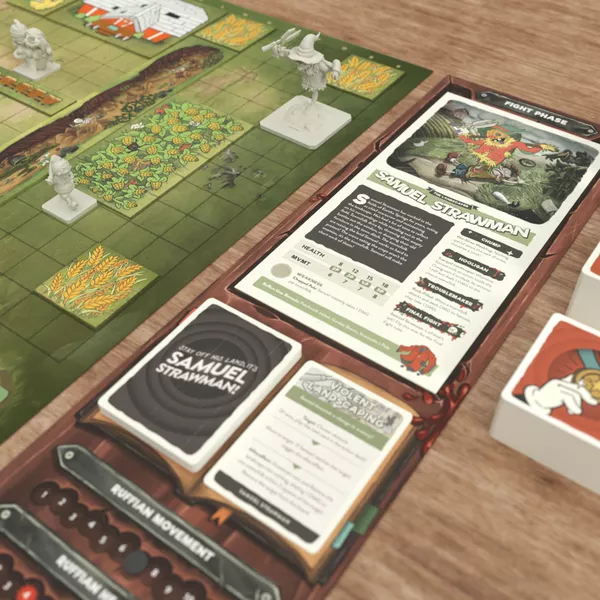Après 3 parties je trouvais justement le jeu trop planplan et surtout les combats assez peu tactique. Je viens de faire un galop d’essai avec cette variante qui ajoute notamment l’importance de l’orientation des figurines et des mouvements et je trouve que ça rend le jeu bien plus intéressant et moins répétitif.
Je remets sous la balise les points de règles maison ajoutés le reste étant plus anecdotique :
Fight rules
1 - Character orientation
Each miniature has a clearly defined orientation, yet this aspect is not taken into account or almost by the game rules.
From now on, the orientation of the miniatures plays an important role during the confrontations, so a miniature never rotates freely, but according to the following rules.
2 - Movement
Since the orientation of the miniatures is now taken into account, the movement rules are slightly modified, and a special diagonal movement is introduced.
When a miniature moves it can:
- Pivot 90° for free before its first move.
- Move forward or shift left or right for 1 MVMT.
- Move backwards for 2 MVMT.
- Run (move 4 squares in a straight line) for 3 MVMT (townsfolk only).
- Rotate 90° for 1 MVMT.
- Move forward once per turn diagonally for 1 MVMT. This special move cannot be used to cut through an occupied square.
- Rotate 90° for free at the end of the move.
In the example below, the townsfolk rotates 90 degrees to the right for free and then spends 3 MVMT to run 4 squares ahead of him to reach square 3, then he moves diagonally for 1 MVMT and reaches square 4. There he pivots to the left for 1 MVMT and moves forward for 1 MVMT. He is on square 6 and can rotate for free if he is not going to move anymore.
:strip_icc()/pic7264107.png)
3 - Line of sight
This rule point allows to create more interesting tactical situations.
Each character has a line of sight in a 180° arc in front of him and to the sides. All squares strictly behind the miniature are not in its line of sight and the miniatures there are ignored, except for adjacent miniatures.
In the example below the Ruffian, whose orientation corresponds to that of the R, sees townsfolk 1 and 2 because they are in his line of sight, does not see 3 because it is in the zone of squares behind him, but is still aware of the presence of 4 because it is adjacent to him.
:strip_icc()/pic7264113.png)
4 - Targeting
When choosing a target, a Ruffian chooses it among the townsfolk in line of sight or adjacent to it. If he has no possible target, he performs a 180° at a cost of 2 MVMT.
If he still has no target, he no longer considers line of sight to choose his target, but only by distance, as the default situation in the original rules.
5 - Attacks from behind
When a miniature attacks another miniature while it is out of its line of sight, the attack receives a +2 to the attack roll.
When a miniature is attacked, it can rotate freely to face its opponent. In the case of a townsfolk, this is at the player’s discretion. In the case of a Ruffian, he always turns towards his opponent if he is adjacent, but if he is not, he turns only if the attack caused him at least 1 DMG.
6 - Critical hits
From now on, no more unpleasant surprises, a critical hit will automatically cause additional damage.
When a critical hit is rolled, it causes +1 DMG anyway, then the player rolls normally on the Critical Hit table to see what extra effect applies.
7 - Aim & Prepare
Each weapon can only be used once, and it’s annoying to sometimes go a turn without having achieved anything because of a failed roll.
When performing an action that costs 1 or more MOX and requires a die roll, a townsfolk may choose to spend an additional 1 MOX to prepare to perform the action, or to aim if it’s an attack.
- If he chooses this option, he rolls two dice and chooses one of the results. The other die is ignored.
- If the dice get a hit and a double, roll on the critical hit table (do not gain +1 DMG as for a standard ! critical hit)
8 - Breakpoints
This is the last rule point which modifies the difficulty according to the number of characters in play. The best would have been to have a track with different breakpoints depending on the number of townsfolk, but you have to work with what is there, so I came up with this rule instead.
Depending on the number of townsfolk currently in play, the rules concerning breakpoints are slightly different.
- 2 townsfolk: when a breakpoint is reached, the active townsfolk can end their turn before triggering the Ruffian bonus activation.
- 3 townsfolk: the normal rules apply.
- 4 townsfolk: When the marker reaches a breakpoint, it stops there! Additional DMGs that should move the marker lower on the track are canceled.

:strip_icc()/pic7264107.png)
:strip_icc()/pic7264113.png)